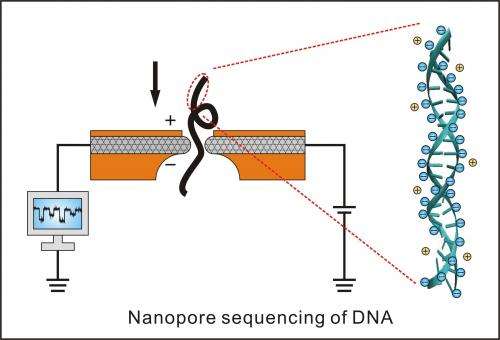The gene sequencing that everyone can afford in future

DNA sequencing is important to science. While Professor Qian Linmao and his group from Tribology Research Institute, Southwest Jiaotong University, were working on the optimization of the third-generation sequencing technique based on nanopores, they found that long-chain DNA with low salt concentration is more conducive to the nanopore sequencing process. Their paper, "Effect of chain length on the conformation and friction behaviour of DNA," was published in Science China Technological Sciences.
When Watson and Crick proposed the double helix structure of DNA in 1953, a significant era was opened for a new stage of life sciences. Since the analysis of DNA sequences can help prevent and treat many genetic diseases, DNA sequencing technology has been a key sector of modern biological research. The Human Genome Project was proposed in the 1970s, taking more than 10 years and $1 billion to complete. In 2005, second-generation sequencing technology was developed, by which the sequencing period for an individual human genome could be reduced to only one week. In recent years, third-generation sequencing based on nanopores has been explored as a potential candidate for achieving the ''$1000 genome'' goal set by the US National Institutes of Health.
In a typical nanopore sequencing process, when a DNA molecule passes through a nanopore, a characteristic blockade ionic current can be detected to determine the structure of the DNA molecule (shown in the image). The process is accurate, rapid, and low-cost. Nevertheless, there are several challenges in nanopore sequencing. For example, the coiled structure of a DNA molecule makes it difficult for one end of a DNA molecule to reach into a nanopore, and the high translocation speed makes it extremely difficult to distinguish the desired current signal. It is essential to solve these problems and improve nanopore sequencing techniques.
In August 2013, Professor Qian and his team reported that low salt concentration is more conducive to the sequencing process, since it can not only make DNA molecules easier to reach into the nanopore through extended conformation, but also reduces the high friction between the DNA molecule and the wall of nanopore. In the present study, the team confirmed that, with the increase of chain length, the DNA molecule became more extended, which can make DNA molecules pass through the nanopore readily. Additionally, the effect of chain length on the friction of DNA was insignificant under low normal load, which indicated that the nanopore sequencing technique was not restricted by the chain length of DNA molecules. In summary, long-chain DNA with low salt concentration is more conducive to the third-generation nanopore sequencing technique and the expectation of longer reads could be realized in the future.
"In the future, everyone could afford to carry out their own gene sequencing," Qian says, "Based on our results, the nanopore sequencing technique is not restricted by the chain length of DNA molecules. It may improve the efficiency of sequencing, which means that the cost of gene sequencing could be further reduced."
On the strength of these findings, the researchers are beginning an extensive project to optimize the parameters of third-generation sequencing. The results will benefit the development of third-generation sequencing, but the benefits will likely extend further, according to Qian.
"There is much more beyond optimization of the nanopore sequencing," Qian says. "A lot of basic research needs to be done and we will work on it."
More information: Wang M, Cui S X, Yun B J, Qian L M. Effect of chain length on the conformation and friction behaviour of DNA. SCI CHINA Tech Sci, 2013 Vol. 56 (12): 2927-2933. tech.scichina.com:8082/sciEe/E … abstract512538.shtml
Provided by Science China Press



















